|
July 3, 2006
Hello from Montreal: One Final Walk Through
Downtown, Admiring Its Architectural Beauties
My exciting long weekend in Montreal unfortunately had to come
to an end. After an exciting day of exploration yesterday that ended
with an absolutely delicious
dinner at Nuances, the fine dining restaurant at the Casino
de Montreal, capped by an impressive pyro-musical performance at
La Ronde, I rested up so I would be able to squeeze in a few more
hours of discovery this morning. One more exploration of the city
before I would have to had back to Toronto on the train before noon.
With all my suitcases duly packed I went off for one more urban
adventure. Fortunately checkout wasn't until noon, so I was able
to leave my luggage at the hotel and just head off with my camera
and my backpack. I started walking west on Rue De La Gauchetière
Ouest which starts off as a fairly small street surrounded by five
or six story high older buildings. The first major sight I came
across was St. Patrick's Basilica.
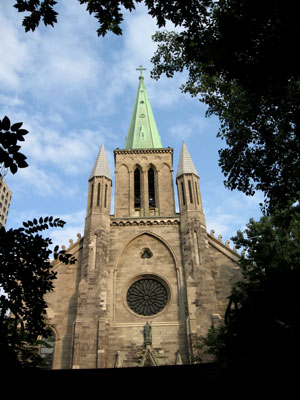
St. Patrick's Basilica
This gothic revival building, a designated Canadian heritage site,
is one of the most magnificent examples of this style in all of
Canada. The massive arrival of Irish immigrants in the early 1800s
created the need for more houses of worship and construction of
St. Patrick's was started in 1843 with the first mass being celebrated
in 1847. The interior of this church features 150 oil paintings
of saints and is known for the "St. Patrick's Chimes",
a chime system composed of ten bells, the oldest of which dates
back to 1774.
I continued west past increasingly modern buildings until I happened
across a major urban square: Dorchester Square,
formerly known as Dominion Square. This wide open public space is
a former cemetery which held the victims of the 1832 cholera epidemic.
Today it holds several statues, including a monument commemorating
the victims of the Boers War, a statue of Robert Burns - a Scottish
poet, and another statue of Sir Wilfried Laurier, a former Canadian
prime minister.
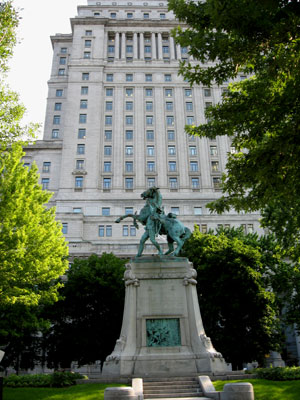
The south side of the square is called Place du Canada,
which is the setting for the annual Remembrance Day ceremony
which honours Canadians that were killed in the First and Second
World Wars as well as the Korean War. Dorchester Square is surrounded
by several magnificent buildings. The north end holds the Dominion
Square Building which is also the location of the Centre
Infotouriste, Montreal Tourism's headquarters.
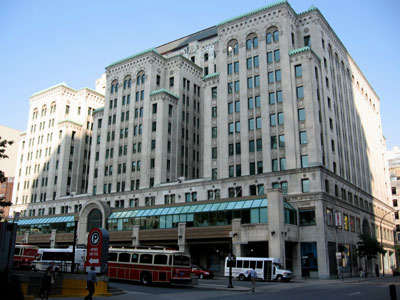
Centre Infotouriste - Dominion Square Building
The east side of Dorchester Square is adorned by one of Montreal's
most astounding buildings: Mary Queen of the World Cathedral.
This impressive church is one of two surviving local churches from
the era before 1875. It illustrates the power that the church wielded
before the Quiet Revolution of the 1960s. One of Montreal's catholic
bishops, Ignace Bourget, devised a grandiose plan to outshine the
Notre Dame Basilica.
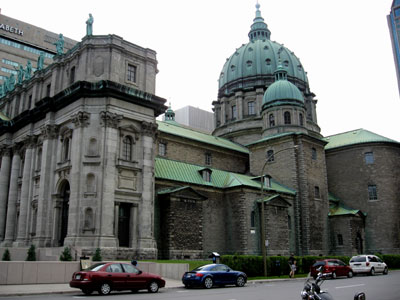
Mary Queen of the World
He decided to commission a church that would be a replica of Rome's
St. Peter's Cathedral with a location right in the middle of a Protestant
neighbourhood. Construction lasted from 1870 to 1894 and the copper
statues of thirteen patron saints of Montreal's parishes were installed
in 1900. The church underwent extensive modernization in the 1950s.
In recent years there has been significant reconstruction and the
statue of Bishop Ignace Bourget outside the cathedral was restored
in 2005. Mary Queen of the World was named a National Historic Site
of Canada on May 14, 2006.
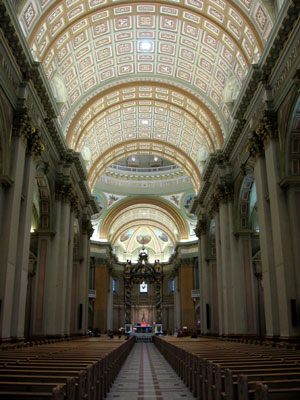
Interior of Mary Queen of the World
Further north on Place du Canada is the Sun Life Building
which was finished in 1931 after three stages of construction. It
was built exclusively for the Sun Life Assurance Company and measures
122 meters in height and counts 24 stories. Although the new head
office of the Royal Bank of Canada at 360 Saint Jacques Street in
Montreal was taller by several floors, the Sun Life Building was
at the time the largest building in terms of square footage anywhere
in the British Empire. The Sun Life Building has historic significance:
during World War II the basement vaults of the Sun Life Building
were the secret hiding place of the Crown Jewels of England and
the gold bullion of the Bank of England. Today it stands as Montreal's
17th highest building.
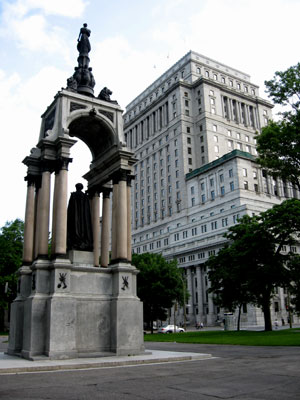
Sun Life Building, Place du Canada
On the West side of Place du Canada are also several historic buildings,
starting with St. George's Anglican Church, a Gothic
Revival-style church, which was opened for worship in October of
1870. Its main features include the magnificent double hammer-beam
roof, one of the largest of its type in the world. The unique column-free
interior combines elements of both English and French Gothic plans,
and the church features magnificent wood carvings in the chancel.
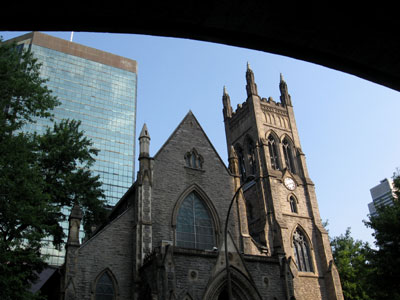
St. George's Anglican Church
The original bells of the church had to be sent out to a country
church since the sound of the 13 bells was considered too loud for
a city church. A new set of 10 bells of a lower tone was installed
in 1901 and the new sound was deemed to be beautiful. The original
architect considered to include a clock in the clock tower but was
concerned about a clock spoiling the appearance. In addition, with
the church facing Windsor Station, the architect was afraid of the
wrath of railway passengers in the event that the clock was going
to be inaccurate. Nevertheless, the clock was installed, only losing
6 seconds a year. A public clock was extremely important to people
at the time since wrist watches had not been invented yet and pocket
watches were difficult to access under thick winter apparel.
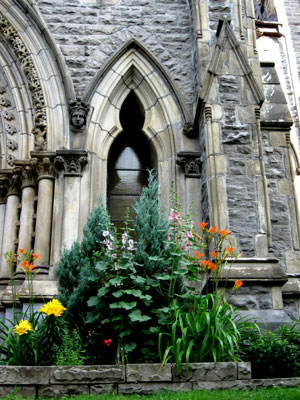
St. George's Anglican Church with its delicately sculpted sandstone
exterior.
Right across the Street from St. George's is Windsor Station
- one of Montreal's historic railway stations. Cornelius
Van Horne, the famous chairman of Canadian Pacific, asked well-known
architect Bruce Price to draw up plans for a modern railway station
in 1887 to serve Canada's transcontinental railroad. Price had already
gained lots of experience from constructing skyscrapers in Manhattan,
he had also built the Chateau Frontenac in Quebec City, the Banff
Springs Hotel and other chateau-style buildings across Canada and
was the prime candidate to build this project. The railway station
opened in 1889 and was enlarged in 1916 with a 15-story main tower.
Windsor Station, built in a solid Richardson Romanesque revival
style, witnessed a big expansion in rail travel in the early 20th
century. In 1979 Windsor Station was abandoned in favour of Montreal's
Gare Centrale for transcontinental passenger traffic, but continued
to house local commuter trains until 1993. Today it holds a hotel,
a variety of stores and offices and the beautifully preserved central
concourse still features the original arrivals and departure board
and is used as a venue for major events. A major beer festival is
also held at the Station annually. In recognition of its historic
and architectural significance Windsor Station was named the first
heritage train station in Canada in 1990.
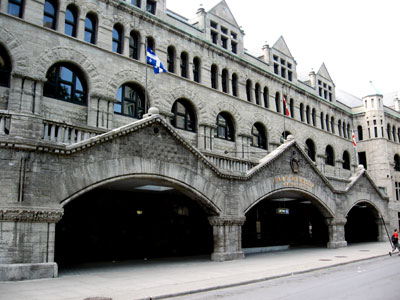
Windsor Station
After my explorations on Dorchester Square I strolled to the north-east
end of this grand public space to enter one of Montreal's most popular
streets: Rue St-Catharines. This street stretches for a length of
15 km and is Montreal's main commercial artery. Hundreds of stores
and fashion retailers are located along this busy street and it
also is the main location of the Montreal Jazz Festival. Since the
1960s several shopping centres have sprouted up and replaced some
of the older townhouses that used to flank this historical thoroughfare.
Montreal's Eaton Centre is the most recent addition to the shopping
centres on St. Catharines.
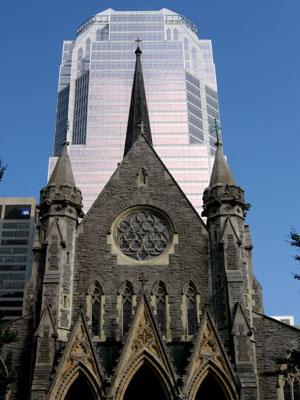
Christ Church Cathedral
This street also features a wealth of historic buildings including
Christ Church Cathedral. This impressive Neo-Gothic
church was built in 1858 and consecrated in 1867 in the growing
Gold Square Mile area. The architect Frank Mills used the cathedral
of Salisbury, his home town, as a model for this building. The church
features a beautiful stained glass window and surprisingly, the
church itself rests on the roofs of an underground mall. Prior to
the construction of the mall, the church was actually sinking into
the soft ground. Indeed the original steeple had to be removed in
1927 due to its heavy weight and a much lighter steeple made of
aluminum was constructed in 1940. Today the underground shopping
centre, whose 1987 excavation required the church to be supported
by concrete beams in mid-air, provides adequate structural support
for the church. The 34-story office tower behind the church is topped
by a crown of thorns and makes for a popular photo motif.
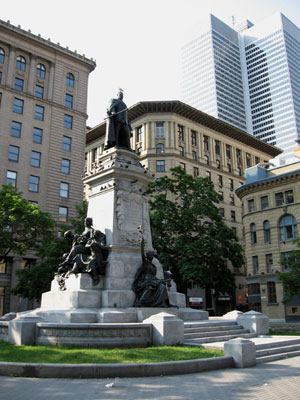
Phillips Square
I continued to walk east on St. Catherines and happened upon Phillips
Square, a beautiful urban space where the retail trade
began in Montreal. Rue St. Catharines had formerly been a purely
residential area. Henry Morgan, a Scottish immigrant with excellent
connections in the dry goods retail trade in Glasgow, had moved
a retail store to a new location at St. Catharines and Phillips
Square after the old city , location of most of the retailers warehouses,
had suffered a devastating flood in 1886. This store, built in the
solid Richardson Romanesque style, later became "The
Bay", for the "Hudson's Bay Company", which
is a chain of about 100 fashion department stores operating throughout
Canada whose origins date back to the fur traders of the 1600s.
The centre of Phillips Square is home to a monument of King Edward
VII, and a Birks jewellery store, located in an
attractive sandstone building, flanks the square on the west side.
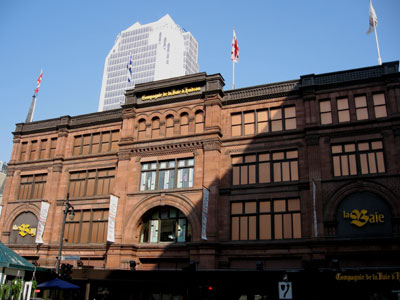
The Bay Department Store
It was getting close to departure time so I speeded up my walk
back to the hotel. There was one more major architectural attraction
on my way: St. James United Church. Completed in
1889, the present St. James Church is the fourth home of the St.
James congregation and due to its impressive size it used to be
known as the Cathedral Church of Methodism. The two towers anchored
around a central large rose window are reminiscent of great French
Gothic cathedrals. As a matter of fact, St. James United Church
was hidden by commercial storefronts from 1926 onwards in order
to raise revenue. The church remained concealed for more than 78
years and after the demolition of the commercial buildings it was
finally uncovered again in 2005 and is currently undergoing some
exterior renovations.
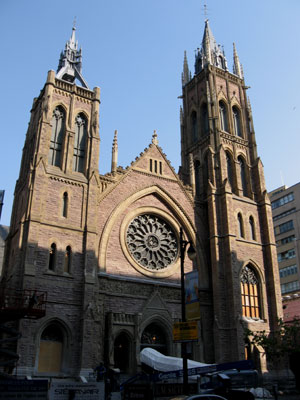
St. James United Church
On my way back to the hotel I thought what amazing architectural
wealth and beauty Montreal has to offer. From Old Montreal and the
Old Port, first and foremost led by Notre-Dame Basilica, to its
stunning Second Empire City Hall area to the historic centres of
commerce on Rue St-Jacques or St. James Street to the magnificent
public and religious buildings that can be seen all over the downtown
core, Montreal dazzles with its architectural heritage.
Any architecture and history buff can't help but love this city
and I realized that three and a half days in this city are barely
enough to scratch the surface. As I settled into my comfortable
seat in the Via Rail coach back to Toronto I concluded that this
trip was just an introduction, a mere overview, a brief taste of
a diverse, multi-faceted city, with so many more places to explore
in detail next time I come back.
Useful books about travel to Montreal:
Related articles:
Hello from Montreal 2006 - My 4-day
explorations of Montreal
Hello from Montreal: An interesting
train ride and first impressions
Hello from Montreal: Getting
the lay of the land in a driving tour
Hello from Montreal: Dinner and a
little jazz at Modavie
Hello from Montreal: Reliving
history with the Old Montreal Ghost Tour
Hello from Montreal: Architectural
discoveries in the Old Montreal Walking Tour
Hello from Montreal: Exploring
the Chateau Ramezay during a torrential downpour
Hello from Montreal:
Mexican delights at La Iguana & a peak at the Jazz Festival
Hello from Montreal: A guided bicycle
tour to explore Montreal's neighbourhoods
Hello from Montreal:
Biking on the Lachine Canal - Industrial history turned into a recreational
opportunity
Hello from Montreal: A chat with
André Giroux about Bicycling in Montreal
Hello from Montreal: Savouring Italian
cuisine at Galiano's and Canada Day Celebrations
Hello from Montreal:
Exploring the Olympic Stadium, the Botanical Garden & Insectarium
and outdoor action at the Jean Talon Market
Hello from Montreal: A Peruvian immigrant
success story at Restaurant Mañana
Hello from Montreal: Friendly
neighbourhood encounters on Square St. Louis
Hello from Montreal: Exploring
the Casino de Montreal
Hello from Montreal: Gourmet
dining at Nuances and amazing fireworks at La Ronde
Hello from Montreal: A final walk
to discover amazing architectural beauties
Helpful links for travel to Montreal:
Tourisme
Montreal - Montreal's official tourism information office
Quebec Tourism
- Official tourism website for Quebec
|